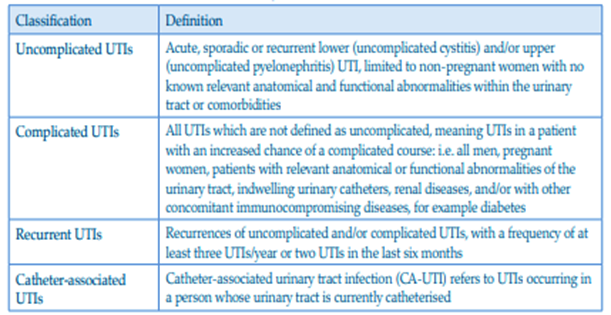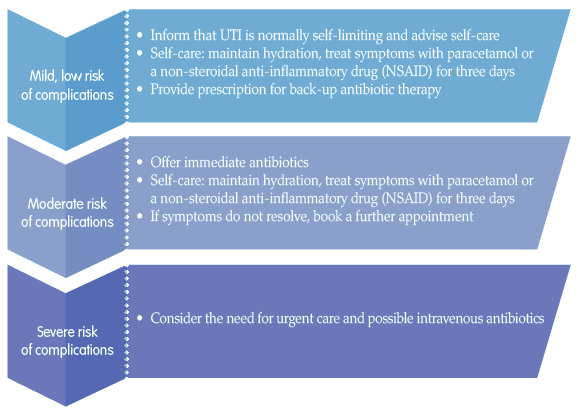References
Ahmed H, Farewell D, Jones HM, et al (2018) Incidence and antibiotic prescribing for clinically diagnosed urinary tract infection in older adults in UK primary care, 2004–2014. PloS One 13(1): e0190521
Altarac S, Papeš D (2014) Comment. BJU Int 113: 9–10
Andrade M, Knight J (2017) Anatomy and physiology of ageing 4: the renal system. Nurs Times 113(5): 46–9
Bean DC, Krahe D, Wareham DW (2008) Antimicrobial resistance in community and nosocomial Escherichia coli urinary tract isolates, London 2005–2006. Ann Clin Microbiol Antimicrob 7: 13
Beerepoot M, Geerlings S (2016) Non-Antibiotic prophylaxis for urinary tract infections. Pathogens (Basel, Switzerland) 5(2): 36
Biggel M, Heytens S, Latour K, et al (2019) Asymptomatic bacteriuria in older adults: the most fragile women are prone to long-term colonization. BMC Geriatr 19: 170
British National Formulary NF (2023) Urinary tract infections. Available online: https://bnf.nice.org.uk/treatment-summary/urinary-tract-infections.html
Butler CC, Hawking MK, Quigley A, McNulty CA (2015) Incidence, severity, help seeking, and management of uncomplicated urinary tract infection: a population-based survey. Br J Gen Pract 65(639): e702–7
Chwa A, Kavanagh K, Linnebur SA, Fixen DR (2019) Evaluation of methenamine for urinary tract infection prevention in older adults: a review of the evidence. Ther Adv Drug Saf 10: 2042098619876749
Cooper E, Jones L, Joseph A, et al (2020) Diagnosis and management of UTI in primary care settings — a qualitative study to inform a diagnostic quick reference tool for women under 65 years. Antibiotics 9(9): 581
Cortes-Penfield NW, Trautner BW, Jump RLP (2017) Urinary tract infection and asymptomatic bacteriuria in older adults. Infect Dis Clin N Am 31: 673–88
Denic A, Glassock RJ, Rule AD (2016) Structural and functional changes with the aging kidney. Adv Chronic Kidney Dis 23(1): 19–28
Dolk FCK, Pouwels KB, Smith DRM, Robotham JV, Smieszek T (2018) Antibiotics in primary care in England: which antibiotics are prescribed and for which conditions? J Antimicrob Chemother 73(suppl 2): ii2–ii10
El-Sharkawy AM, Sahota O, Maughan RJ, Lobo DN (2014) The pathophysiology of fluid and electrolyte balance in the older adult surgical patient. Clin Nutr (Edinburgh, Scotland) 33(1): 6–13
European Association of Urology (2023) Urological Infections guideline. Available online: https://uroweb.org/guideline/urological-infections/
Evans M (2019) Why are STIs on the rise in older people? Patient info. Available online: https://patient.info/news-and-features/why-are-stis-on-the-rise-in-older-people
Franklin BD, Abel G, Shojania KG (2020) Medication non-adherence: an overlooked target for quality improvement interventions. BMJ Quality Saf 29: 271–3
Fu Z, Liska D, Talan D, Chung M (2017) Cranberry reduces the risk of urinary tract infection recurrence in otherwise healthy women: a systematic review and meta-analysis. J Nutr 147(12): 2282–88
Gallagher A (2023) GSK’s Gepotidacin shows potential as first-in-class drug for uncomplicated UTIs. Pharmacy Times. Available online: www.pharmacytimes.com/view/gsk-s-gepotidacin-shows-potential-as-first-in-class-drug-for-uncomplicated-utis
Givler DN, Givler A (2023) Asymptomatic bacteriuria. [Updated 2023 Jul 17]. In: StatPearls [Internet]. Treasure Island (FL): StatPearls Publishing; 2023 Jan. Available online: www.ncbi.nlm.nih.gov/books/NBK441848/
Jarvis S (2023) Lower Urinary Tract Symptoms in Women. Patient Plus. Available online: https://patient.info/womens-health/lower-urinary-tract-symptoms-in-women-luts
Kleinsinger F (2018) The unmet challenge of medication nonadherence. Permanente J 22: 18–033
Little P, Moore MV, Turner S, et al (2010) Effectiveness of five different approaches in management of urinary tract infection: randomised controlled trial. BMJ (clinical research edn) 340: c199
Lutters M, Vogt-Ferrier NB (2008) Antibiotic duration for treating uncomplicated, symptomatic lower urinary tract infections in elderly women. Cochrane Database Syst Rev 3: CD001535
Mahmood RK, Gillani SW, Alzaabi MJ, Gulam SM (2022) Evaluation of inappropriate antibiotic prescribing and management through pharmacist-led antimicrobial stewardship programmes: a meta-analysis of evidence. Eur J Hosp Pharm 29(1): 2–7
Medicines and Healthcare Products Regulatory Agency (2019a) EMA’s final recommendation on quinolone and fluoroquinolone-containing medicinal products. Drug Safety Update 12(8): 1. Available online: www.gov.uk/drug-safety-update/fluoroquinolone-antibiotics-new-restrictions-and-precautions-for-use-due-to-very-rare-reports-of-disabling-and-potentially-long-lasting-or-irreversible-side-effects
Medicines and Healthcare products Regulatory Agency (2019b) Fluoroquinolone antibiotics (oxacins) what you need to know about side-effects of tendons, muscles, joints, and nerves. Available online: https://assets.publishing.service.gov.uk/media/5c9364c6e5274a48edb9a9fa/FQ-patient-sheet-final.pdf
Michaels T, Sands J (2015) Dysuria: evaluation and differential diagnosis in adults. Am Fam Physician 92(9): 778–86
Mohsen S, Dickinson JA, Somayaji R (2020) Update on the adverse effects of antimicrobial therapies in community practice. Can Fam Physician 66(9): 651–9
NHS England (2023) NHS to expand soups and shakes for people with type 2 diabetes. Available online: www.england.nhs.uk/2023/04/nhs-to-expand-soups-and-shakes-for-people-with-type-2-diabetes/
National Institute for Health and Care Excellence (2016) Sepsis: Recognition, diagnosis and early management. NICE, London. Available online: www.nice.org.uk/guidance/ng51/resources/sepsis-recognition-diagnosis-and-early-management-1837508256709
National Institute for Health and Care Excellence (2018) Urinary tract infection (recurrent): antimicrobial prescribing. NICE guideline [NG112]. NICE, London. Available online: www.nice.org.uk/guidance/ng112
National Institute for Health and Care Excellence (2023a) Urinary tract infections in adults. Quality standard [QS90] Published: 11 June 2015 Last updated: 15 February 2023. Available online: www.nice.org.uk/guidance/qs90/chapter/Quality-statement-4-Duration-of-antibiotic-treatment-for-urinary-tract-infection
National Institute for Health and Care Excellence (2023b) Urinary tract infection (lower) — women. Clinical Knowledge Summary, NICE, London. Available online: https://cks.nice.org.uk/topics/urinary-tract-infection-lower-women/background-information/definition/
Palin V, Molter A, Belmotne M, et al (2019) Antibiotic prescribing for common infections in UK general practice: variability and drivers. J Antimicrob Chemother 74(8): 2440–50
Pipitone F, Sadeghi Z, DeLancey JOL (2021) Urethral function and failure: A review of current knowledge of urethral closure mechanisms, how they vary, and how they are affected by life events. Neurourol Urodyn 40(8): 1869–79
Public Health England (2018) Diagnosis of urinary tract infections. Quick reference tool for primary care: for consultation and local adaptation. PHE, London. Available online: www.gov.uk/government/publications/urinary-tract-infection-diagnosis
Pujades-Rodriguez M, West RM, Wilcox MH, Sandoe J (2019) Lower urinary tract infections: management, outcomes and risk factors for antibiotic re-prescription in primary care. eClinicalMedicine, Lancet 14: 23–31. Available online: www.thelancet.com/journals/eclinm/article/PIIS2589-5370(19)30120-8/fulltext
Robinson D, Toozs-Hobson P, Cardozo L (2013) The effect of hormones on the lower urinary tract. Menopause Int 19(4): 155–62
Schwenger EM, Tejani AM, Loewen PS (2015) Probiotics for preventing urinary tract infections in adults and children. Cochrane Database Syst Rev 12: CD008772
Sloane PD, Kistler CE, Reed D, Weber D J, Ward K, Zimmerman S (2017) Urine culture testing in community nursing homes: gateway to antibiotic overprescribing. Infect Control Hosp Epidemiol 38(5): 524–31
Smith DM, Dolk FCK, Pouwels KB, et al (2018) Defining the appropriateness and inappropriateness of antibiotic prescribing in primary care. J Antimicrob Chemother 73(suppl 2): ii11–ii18
Smith PP, Kuchel GA (2017) Aging of the urinary tract. In: Fillit HM, Rockwood K, Young J, eds. Brocklehurst’s Textbook of Geriatric Medicine and Gerontology. 8th edn. Elsevier Philadelphia, PA: chap 22
UK Health Security Agency (2022) English surveillance programme for antimicrobial utilisation and resistance (ESPAUR) Report 2021 to 2022. Available online: https://assets.publishing.service.gov.uk/government/uploads/system/uploads/attachment_data/file/1118310/ESPAUR-report-2021-to-2022.pdf
Willacy H (2022) Atrophic vaginitis: causes, symptoms, and treatment. Patient Plus. Available online: https://patient.info/doctor/atrophic-vaginitis
Williams G, Hahn D, Stephens JH, Craig JC, Hodson EM (2023) Cranberries for preventing urinary tract infections. Cochrane Database Syst Rev 4(4): CD001321
World Health Organization (2016) Global action plan on antimicrobial resistance. Available online: www.who.int/publications/i/item/9789241509763
Young A, Toncar A, Wray AA (2022) Urethritis. [Updated 2022 Dec 1]. In: StatPearls [Internet]. Treasure Island (FL): StatPearls Publishing; 2023 Jan. Available online: www.ncbi.nlm.nih.gov/books/NBK537282/
Zalmanovici Trestioreanu A, Green H, Paul M, Yaphe J, Leibovici L (2010) Antimicrobial agents for treating uncomplicated urinary tract infection in women. Cochrane Database Syst Rev 10: CD007182
Altarac S, Papeš D (2014) Comment. BJU Int 113: 9–10
Andrade M, Knight J (2017) Anatomy and physiology of ageing 4: the renal system. Nurs Times 113(5): 46–9
Bean DC, Krahe D, Wareham DW (2008) Antimicrobial resistance in community and nosocomial Escherichia coli urinary tract isolates, London 2005–2006. Ann Clin Microbiol Antimicrob 7: 13
Beerepoot M, Geerlings S (2016) Non-Antibiotic prophylaxis for urinary tract infections. Pathogens (Basel, Switzerland) 5(2): 36
Biggel M, Heytens S, Latour K, et al (2019) Asymptomatic bacteriuria in older adults: the most fragile women are prone to long-term colonization. BMC Geriatr 19: 170
British National Formulary NF (2023) Urinary tract infections. Available online: https://bnf.nice.org.uk/treatment-summary/urinary-tract-infections.html
Butler CC, Hawking MK, Quigley A, McNulty CA (2015) Incidence, severity, help seeking, and management of uncomplicated urinary tract infection: a population-based survey. Br J Gen Pract 65(639): e702–7
Chwa A, Kavanagh K, Linnebur SA, Fixen DR (2019) Evaluation of methenamine for urinary tract infection prevention in older adults: a review of the evidence. Ther Adv Drug Saf 10: 2042098619876749
Cooper E, Jones L, Joseph A, et al (2020) Diagnosis and management of UTI in primary care settings — a qualitative study to inform a diagnostic quick reference tool for women under 65 years. Antibiotics 9(9): 581
Cortes-Penfield NW, Trautner BW, Jump RLP (2017) Urinary tract infection and asymptomatic bacteriuria in older adults. Infect Dis Clin N Am 31: 673–88
Denic A, Glassock RJ, Rule AD (2016) Structural and functional changes with the aging kidney. Adv Chronic Kidney Dis 23(1): 19–28
Dolk FCK, Pouwels KB, Smith DRM, Robotham JV, Smieszek T (2018) Antibiotics in primary care in England: which antibiotics are prescribed and for which conditions? J Antimicrob Chemother 73(suppl 2): ii2–ii10
El-Sharkawy AM, Sahota O, Maughan RJ, Lobo DN (2014) The pathophysiology of fluid and electrolyte balance in the older adult surgical patient. Clin Nutr (Edinburgh, Scotland) 33(1): 6–13
European Association of Urology (2023) Urological Infections guideline. Available online: https://uroweb.org/guideline/urological-infections/
Evans M (2019) Why are STIs on the rise in older people? Patient info. Available online: https://patient.info/news-and-features/why-are-stis-on-the-rise-in-older-people
Franklin BD, Abel G, Shojania KG (2020) Medication non-adherence: an overlooked target for quality improvement interventions. BMJ Quality Saf 29: 271–3
Fu Z, Liska D, Talan D, Chung M (2017) Cranberry reduces the risk of urinary tract infection recurrence in otherwise healthy women: a systematic review and meta-analysis. J Nutr 147(12): 2282–88
Gallagher A (2023) GSK’s Gepotidacin shows potential as first-in-class drug for uncomplicated UTIs. Pharmacy Times. Available online: www.pharmacytimes.com/view/gsk-s-gepotidacin-shows-potential-as-first-in-class-drug-for-uncomplicated-utis
Givler DN, Givler A (2023) Asymptomatic bacteriuria. [Updated 2023 Jul 17]. In: StatPearls [Internet]. Treasure Island (FL): StatPearls Publishing; 2023 Jan. Available online: www.ncbi.nlm.nih.gov/books/NBK441848/
Jarvis S (2023) Lower Urinary Tract Symptoms in Women. Patient Plus. Available online: https://patient.info/womens-health/lower-urinary-tract-symptoms-in-women-luts
Kleinsinger F (2018) The unmet challenge of medication nonadherence. Permanente J 22: 18–033
Little P, Moore MV, Turner S, et al (2010) Effectiveness of five different approaches in management of urinary tract infection: randomised controlled trial. BMJ (clinical research edn) 340: c199
Lutters M, Vogt-Ferrier NB (2008) Antibiotic duration for treating uncomplicated, symptomatic lower urinary tract infections in elderly women. Cochrane Database Syst Rev 3: CD001535
Mahmood RK, Gillani SW, Alzaabi MJ, Gulam SM (2022) Evaluation of inappropriate antibiotic prescribing and management through pharmacist-led antimicrobial stewardship programmes: a meta-analysis of evidence. Eur J Hosp Pharm 29(1): 2–7
Medicines and Healthcare Products Regulatory Agency (2019a) EMA’s final recommendation on quinolone and fluoroquinolone-containing medicinal products. Drug Safety Update 12(8): 1. Available online: www.gov.uk/drug-safety-update/fluoroquinolone-antibiotics-new-restrictions-and-precautions-for-use-due-to-very-rare-reports-of-disabling-and-potentially-long-lasting-or-irreversible-side-effects
Medicines and Healthcare products Regulatory Agency (2019b) Fluoroquinolone antibiotics (oxacins) what you need to know about side-effects of tendons, muscles, joints, and nerves. Available online: https://assets.publishing.service.gov.uk/media/5c9364c6e5274a48edb9a9fa/FQ-patient-sheet-final.pdf
Michaels T, Sands J (2015) Dysuria: evaluation and differential diagnosis in adults. Am Fam Physician 92(9): 778–86
Mohsen S, Dickinson JA, Somayaji R (2020) Update on the adverse effects of antimicrobial therapies in community practice. Can Fam Physician 66(9): 651–9
NHS England (2023) NHS to expand soups and shakes for people with type 2 diabetes. Available online: www.england.nhs.uk/2023/04/nhs-to-expand-soups-and-shakes-for-people-with-type-2-diabetes/
National Institute for Health and Care Excellence (2016) Sepsis: Recognition, diagnosis and early management. NICE, London. Available online: www.nice.org.uk/guidance/ng51/resources/sepsis-recognition-diagnosis-and-early-management-1837508256709
National Institute for Health and Care Excellence (2018) Urinary tract infection (recurrent): antimicrobial prescribing. NICE guideline [NG112]. NICE, London. Available online: www.nice.org.uk/guidance/ng112
National Institute for Health and Care Excellence (2023a) Urinary tract infections in adults. Quality standard [QS90] Published: 11 June 2015 Last updated: 15 February 2023. Available online: www.nice.org.uk/guidance/qs90/chapter/Quality-statement-4-Duration-of-antibiotic-treatment-for-urinary-tract-infection
National Institute for Health and Care Excellence (2023b) Urinary tract infection (lower) — women. Clinical Knowledge Summary, NICE, London. Available online: https://cks.nice.org.uk/topics/urinary-tract-infection-lower-women/background-information/definition/
Palin V, Molter A, Belmotne M, et al (2019) Antibiotic prescribing for common infections in UK general practice: variability and drivers. J Antimicrob Chemother 74(8): 2440–50
Pipitone F, Sadeghi Z, DeLancey JOL (2021) Urethral function and failure: A review of current knowledge of urethral closure mechanisms, how they vary, and how they are affected by life events. Neurourol Urodyn 40(8): 1869–79
Public Health England (2018) Diagnosis of urinary tract infections. Quick reference tool for primary care: for consultation and local adaptation. PHE, London. Available online: www.gov.uk/government/publications/urinary-tract-infection-diagnosis
Pujades-Rodriguez M, West RM, Wilcox MH, Sandoe J (2019) Lower urinary tract infections: management, outcomes and risk factors for antibiotic re-prescription in primary care. eClinicalMedicine, Lancet 14: 23–31. Available online: www.thelancet.com/journals/eclinm/article/PIIS2589-5370(19)30120-8/fulltext
Robinson D, Toozs-Hobson P, Cardozo L (2013) The effect of hormones on the lower urinary tract. Menopause Int 19(4): 155–62
Schwenger EM, Tejani AM, Loewen PS (2015) Probiotics for preventing urinary tract infections in adults and children. Cochrane Database Syst Rev 12: CD008772
Sloane PD, Kistler CE, Reed D, Weber D J, Ward K, Zimmerman S (2017) Urine culture testing in community nursing homes: gateway to antibiotic overprescribing. Infect Control Hosp Epidemiol 38(5): 524–31
Smith DM, Dolk FCK, Pouwels KB, et al (2018) Defining the appropriateness and inappropriateness of antibiotic prescribing in primary care. J Antimicrob Chemother 73(suppl 2): ii11–ii18
Smith PP, Kuchel GA (2017) Aging of the urinary tract. In: Fillit HM, Rockwood K, Young J, eds. Brocklehurst’s Textbook of Geriatric Medicine and Gerontology. 8th edn. Elsevier Philadelphia, PA: chap 22
UK Health Security Agency (2022) English surveillance programme for antimicrobial utilisation and resistance (ESPAUR) Report 2021 to 2022. Available online: https://assets.publishing.service.gov.uk/government/uploads/system/uploads/attachment_data/file/1118310/ESPAUR-report-2021-to-2022.pdf
Willacy H (2022) Atrophic vaginitis: causes, symptoms, and treatment. Patient Plus. Available online: https://patient.info/doctor/atrophic-vaginitis
Williams G, Hahn D, Stephens JH, Craig JC, Hodson EM (2023) Cranberries for preventing urinary tract infections. Cochrane Database Syst Rev 4(4): CD001321
World Health Organization (2016) Global action plan on antimicrobial resistance. Available online: www.who.int/publications/i/item/9789241509763
Young A, Toncar A, Wray AA (2022) Urethritis. [Updated 2022 Dec 1]. In: StatPearls [Internet]. Treasure Island (FL): StatPearls Publishing; 2023 Jan. Available online: www.ncbi.nlm.nih.gov/books/NBK537282/
Zalmanovici Trestioreanu A, Green H, Paul M, Yaphe J, Leibovici L (2010) Antimicrobial agents for treating uncomplicated urinary tract infection in women. Cochrane Database Syst Rev 10: CD007182






